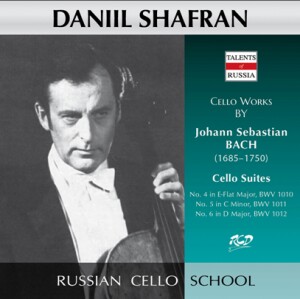
Daniil Shafran. Bach Cello Suites. Russian Compact Disc RCD13019/20. Auditioned using Tidal Hi Fi streaming service.
Original recording spans 1969-74.
Recording venue unknown.
Cello used, Antonio Amati, won in competition 1937 and used throughout artist’s career.
Introduction.
Daniil Shafran is a Russian cellist and contemporary of Rostropovich. Shafran achieved much less prominence outside the USSR than his fellow countryman for a variety of reasons. These links go into far more detail than suitable for this review but are well worth reading if you are curious.
https://en.wikipedia.org/wiki/Daniil_Shafran
This personal encounter by Stephen Isserlis.
https://www.classicus.jp/shafran/articles/isserlis.html
By all accounts, Shafran appears to have been a fastidious and hardworking cellist, with highly individual approach to technique, practice and musicality.
The Recording.
This recording is available in many different forms and original tapes even appear to have been remastered in DSD form. This auditioned release does not to my ears have any characteristics of high quality having a slightly shut-in sound stage with the cellist set well back. No chance of being troubled by any breathing noises! However, in loud passages there are obvious knocks of cellist with cello. I felt sorry for the Amati!
When initially listening I initially thought this was a 60s based recording which in some ways is probably a result of the extraordinary vibrato used by the cellist. It reminds me of recordings by Beatrice Harrison! (Not an insult by the way.)
The Music.
Starting with a conclusion first I should advise readers that mindful of what is written elsewhere I did listen to other recordings by Shafran particularly the Rachmaninov sonata. It seems self-evident that this cellist’s style of playing was far more suited to romantic composers than Bach. So, if my comments sound negative please bear this in mind!
This is a very idiosyncratic interpretation, with very slow Sarabandes and very fast Courantes. It is interesting to read that in practice Shafran would play at double speed and sometimes higher registers. Certainly his facility is impressive both for rapid and high passages.
From the beginning I noted that in the Prelude cross string passages the cellist tended to veer towards double stopping rather than separating the notes out. This tended to be the case in any similar situation throughout. I thought it quite enjoyable and wondered why I had not heard it done before!
Less enjoyable was the very varied and extreme vibrato employed. At times it was very wide and quite slow. The cello sometimes sounds like a bleating lamb! At other times there is very little, particularly in quieter passages.
Shafran seems to focus on cramming in every device he knows to pack as much musical intensity into the piece he is playing. This feels to be a little at the expense of a coherent and rhythmically satisfying performance.
I cannot find any detail as to whether these are studio, live or a mix of recordings. There was audience appreciation heard at the end of the second and fifth suite only, but otherwise no audible coughs etc. Generally, intonation was reliable although a few movements ended with a rather flat sounding note!
Conclusion.
In summary this is not a recording of the Suites for anybody other than a die- hard enthusiast. The eccentricities of Shafran’s approach to Bach make it a difficult listen for me. There were many times when I found my jaw clenching with forced over dramatic passages. In fact, the whole performance was very theatrical, so much so that I was reminded of the silent movies where visual clues were exaggerated to overcome lack of dialogue. In this case it is clearly a case of turning things on their head using sound to overcome lack of visual clues! Having been rather severe in my comments, I do take my hat off to a performer who steadfastly travels down the road of his own choosing with such determination.
Charles.